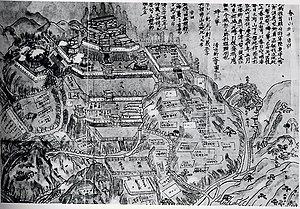Kasugayama Castle
| Kasugayama Castle | |
|---|---|
春日山城 | |
| Jōetsu, Niigata, Japan | |
 An old print showing Kasugayama Castle, built by Uesugi Kenshin. | |
| Type | Japanese castle |
| Site information | |
| Controlled by | Nagao clan, Uesugi clan, Hori clan |
| Condition | Ruins; only earthwork walls and dry moat remain |
| Site history | |
| Built | Year Unknown |
| Built by | Nagao clan |
| In use | until 1607 |
| Garrison information | |
| Past commanders | Uesugi Kenshin, Uesugi Kagekatsu |
Kasugayama Castle (春日山城, Kasugayama-jō) was the primary fortress of the Japanese warlord Uesugi Kenshin during the Sengoku period. It is situated in what is now the city of Jōetsu, Niigata prefecture, and was originally built and ruled by the Nagao clan.
Uesugi Kenshin, who was originally Nagao Kagetora, became the lord of the castle in 1548.
This castle was Uesugi Kenshin's departure point in his engagement with Takeda Shingen in the 1561 Battle of Kawanakajima.[1]
After his death in 1578, his nephew Uesugi Kagekatsu gained control of it, after a brief series of battles with Uesugi Kagetora, Kenshin's adopted son, over the inheritance. Twenty years later, the Hori clan became the lords of Kasugayama; but they decided it was not a good place to rule from, so they built a new castle at Fukushima and, in 1607, Kasugayama's last castle lords left.
The castle is unofficially called Hachigamine Castle, the name Kasuga (lit. spring day) coming from a connection to Kasuga Taisha, a major Shinto shrine in Nara.
Significance
Kasugayama Castle is regarded as among Japan's Five Greatest Mountain Castles, along with Nanao Castle, Odani Castle, Kannonji Castle and Gassantoda Castle.
Literature
- ^ Turnbull, Stephen (1987). Battles of the Samurai. Arms and Armour Press. p. 47. ISBN 0853688265.
- Motoo, Hinago (1986). Japanese Castles. Tokyo: Kodansha. p. 200 pages. ISBN 0-87011-766-1.
